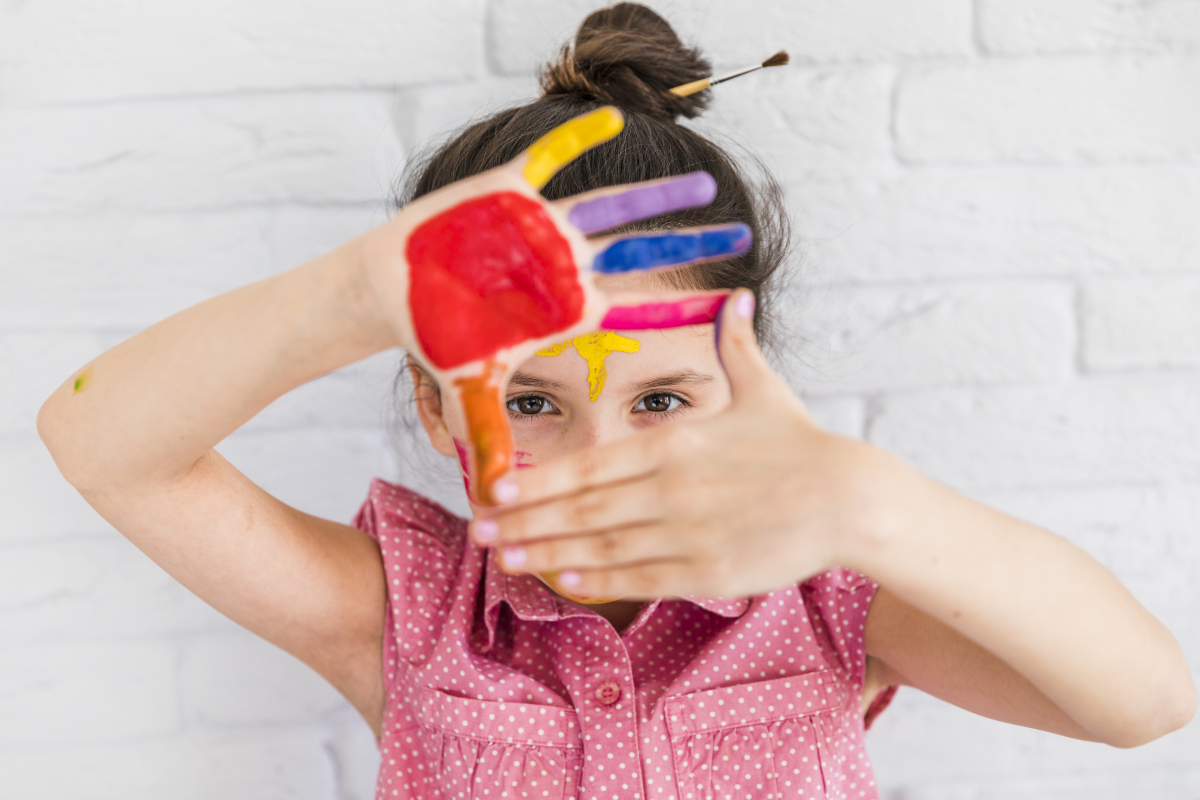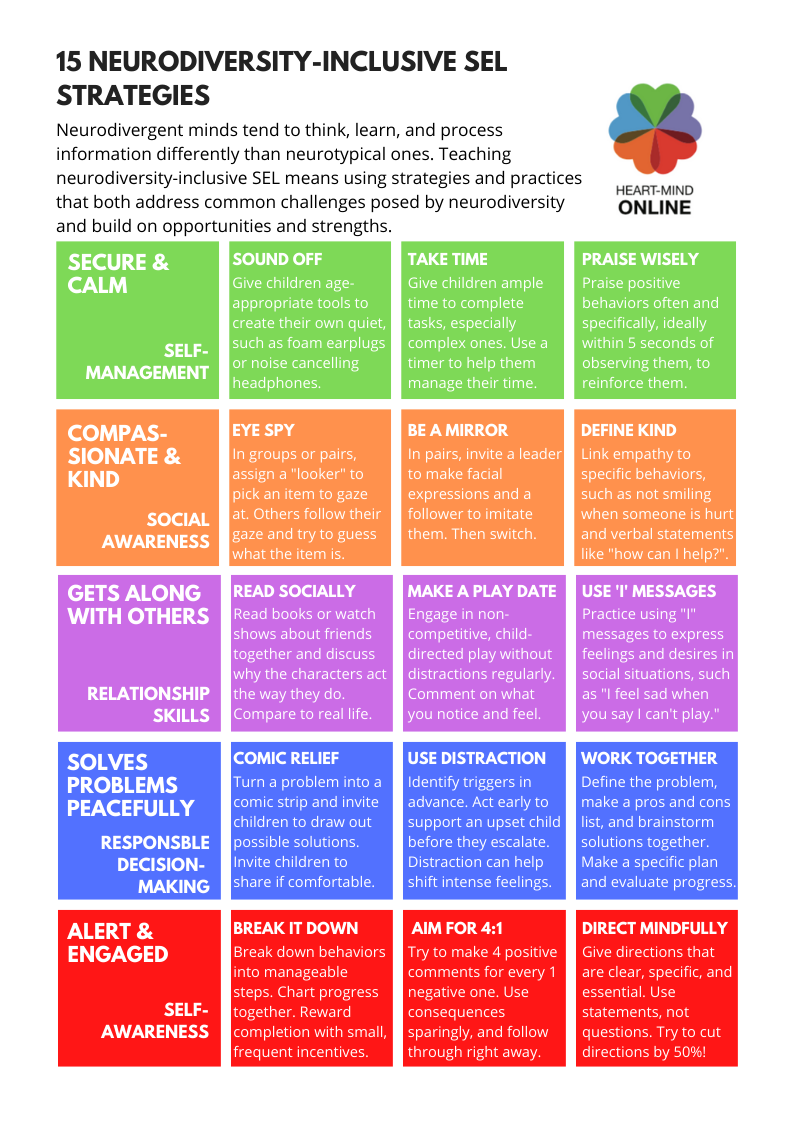 Social emotional learning (SEL) [1]equips children with the skills they need to thrive in relationship to self and others throughout their lives. While the five core dimensions of SEL[2] – which align with the five Heart-Mind qualities – are universal, there is no one-size-fits-all approach to nurturing them in children within our parenting, caregiving and teaching relationships. Inclusive education tells us that we must teach to the “outside pins”[3] to be effective and equitable in our approaches. It also tells us that when we design our lessons and supports to help the children who are hardest to reach, all children stand to benefit immensely.
Social emotional learning (SEL) [1]equips children with the skills they need to thrive in relationship to self and others throughout their lives. While the five core dimensions of SEL[2] – which align with the five Heart-Mind qualities – are universal, there is no one-size-fits-all approach to nurturing them in children within our parenting, caregiving and teaching relationships. Inclusive education tells us that we must teach to the “outside pins”[3] to be effective and equitable in our approaches. It also tells us that when we design our lessons and supports to help the children who are hardest to reach, all children stand to benefit immensely.
Bringing an inclusive lens to fostering SEL means being mindful of the different environments, contexts, and histories that children inhabit and bring to their places of learning, be they at home, in nature, or in schools. Inclusive SEL also requires us to attune to the differences in brain functionality that are present across populations, which are acknowledged and celebrated by the neurodiversity[4] movement.
Fostering neurodiversity-inclusive SEL means using strategies and practices that both address common challenges posed by neurodiversity and build on opportunities and strengths[5]. While the following strategies, which are organized according to the 5 Heart-Mind Qualities and corresponding SEL dimensions, are especially accessible for neurodivergent children, they are also excellent tools for nurturing SEL in neurotypical children alongside them.
Download the Infographic here!
15 Neurodiversity-Inclusive SEL Strategies
Secure & Calm/Self-Management:
- Sound off - Give children age-appropriate tools to create their own quiet[6], such as foam earplugs or noise cancelling headphones.
- Take time - Give children ample time to complete tasks, especially complex ones. Time pressure[7] can be a major stressor for neurodivergent children, many of whom process the passage of time differently.
- Praise wisely - Praise positive behaviors[8] often and specifically, ideally within 5 seconds of observing them, to reinforce them. Praising the absence of negative behaviors is another effective strategy.
Compassionate & Kind/Social Awareness:
- Eye spy - In groups or pairs, assign a "looker" to pick an item to gaze at. Others follow their gaze[9] and try to guess what the item is. No talking allowed! If the child prefers working alone, they might enjoy helping aliens chart their path to outer space using the Think With Your Eyes Thinksheet!
- Be a mirror - In pairs, invite a leader to make facial expressions[10] and a follower to imitate them. Then switch. The more outrageous, the better!
- Define kind - Link empathy to specific behaviors[11], such as not smiling when someone is hurt, verbal statements like "how can I help?", and responding with appropriate intonation and gestures (eg. Hugging, waving, etc).
Gets Along with Others/Relationship Skills
- Read socially - Read books or watch shows about friendship together and discuss why the characters act the way they do. Encourage children to imagine how the characters feel[12].
- Make a play date – As an adult, engage in non-competitive, child-directed play without distractions regularly. Participate in the play as an “actor” by commenting on what you notice and feel, and letting the child lead. [13]
- Use “I” messages - Practice using "I" messages to express feelings and desires in social situations[14], such as "I feel sad when you say I can't play.” Model this way of speaking when you are upset.
Solves Problems Peacefully/Responsible Decision Making
- Comic relief - Turn a problem into a comic strip[15] and invite children to draw out possible solutions. Some children are visual thinkers and benefit from having quiet time to draw out their thoughts before discusisng them.
- Use distraction – When emotions start to escalate[16], remove the child from the triggering situation or environment and distract them with a preferred activity such as coloring, listening to an audiobook, or moving their bodies to short-circuit their activated fight-flight-freeze response.
- Work together - Define the problem, make a pros and cons list, and brainstorm solutions together[17]. Use a task planning template like Ready, Do, Done to simplify the process and keep things on track.
Alert & Engaged/Self-Awareness
- Break it down - Break down desired behaviors into manageable steps.Chart progress together, using concrete methods such as a sticker chart. Reward completion[18] with small, frequent incentives that the child helps select.
- Aim for 4:1 - Try to make 4 positive comments for every 1 negative one. Use consequences sparingly, and follow through right away – consequences are most effective when they are consistent and not overused[19].
- Direct mindfully - Give directions that are clear, specific, and essential. Give directions as statements, not questions. On a daily basis, aim to reduce the directions you give by 50%![20]

Photo credit: freepik.com
SEL is “the process through which all young people and adults acquire and apply the knowledge, skills, and attitudes to develop healthy identities, manage emotions and achieve personal and collective goals, feel and show empathy for others, establish and maintain supportive relationships, and make responsible and caring decisions.”
According to Collaborative for Academic, Social, and Emotional Learning (CASEL), the five dimensions of SEL are self-awareness, self-management, social awareness, relationship skills, and responsible decision-making. Check out CASEL’s interactive SEL wheel to learn more.
According to inclusive education scholar and advocate Dr. Shelley Moore, the “outside pins” are a bowling metaphor used to describe children who are hardest to reach in learning settings.
This neurodiversity strengths checklist can help identify personal strengths in primary and preschool aged children.
Neurodiversity refers to the way that some brains are “wired” differently, and think, learn, and process information differently as a result. Autism, ADHD, and dyslexia are common examples of variations in brain “wiring” that can be considered neurodivergent. The neurodiversity movement affirms such variations as different than neurotypical brains, but not deficient or disabled. Through a neurodiversity lens, young people with neurodivergent minds deserve learning environments and resources that support them to be successful because of – not in spite of – their unique ways of seeing and knowing. Click "more" to learn about the history of the neurodiversity movement.
Sensory processing issues are common in neurodivergent children. Equipping them with supports and resources to manage their sensory inputs and prevent sensory overwhelm is an empowering and effective strategy to prevent potential meltdowns.
Use time management techniques like dividing up an analogue clock like a pie and marking deadlines on it using dry erase markers to support efficient time usage and on-time completion of tasks.
To encourage a growth mindset, praise should be process and effort focused, rather than highlighting innate talents and skills (think: "you tried SO hard to write neatly, well done!" Rather than "you’re such a neat writer!").
Eye contact can be challenging for some neurodivergent children, especially those with Autism Spectrum Disorder. Playing games that require players to look into each others' eyes can help build comfort with eye contact, which is an important skill for understanding others’ emotions, in a fun, low pressure way.
Followers can also try to name the expressions. Facial expressions provide important insight into what others are thinking and feeling. Reading facial expressions facilitates perspective taking, which is an important building block for compassion.
Notice when the child shows empathic behavior, and praise them often to reinforce it! Other helpful strategies for teaching empathy to neurodivergent children, and especially those with Autism Spectrum Disorder, can be found here.
Then, invite children to imagine social scenarios they might encounter in real life, and brainstorm how their favourite characters might behave in them.
When the play session is over, resume your adult role as the “director” to maintain healthy boundaries and clearly defined adult/child roles that help children feel safe.
Coach the child to use “I” messages in social situations, especially when emotions are running high.
There are plenty of blank comic strip printouts online, though some children may prefer a comic building ap to pencil and paper. Invite children to share their comics once they are completed, but only if they feel comfortable doing so.
Identify potential triggers in advance – situations or events that you know are likely to cause an emotional reaction in the child. Act early to support an upset child before they escalate. While breathing and mindfulness techniques may be useful, distraction is another important tool for shifting intense feelings.
Some children may appreciate mapping out the problem visually, such as in a mind map. Make a specific plan, step-by-step, for resolving the issue. Evaluate your progress together as you work through each stage of the plan, and celebrate together when you complete it!
Emphasize effort and progress, not perfection – they don’t have to be 100% perfect to achieve their goals or be rewarded for their efforts!
Sometimes, natural consequences are the most logical outcome of an undesired behavior. Refrain from overexplaining natural consequences. Avoid using consequences when health or safety are at risk.
Neurodivergent children, such as those with ADHD, may receive over twice as many directions in a day as their neurotypical peers! It’s no surprise, then, that many are experts at tuning directions out.
Think twice before directing – is it a behavior they have the ability to change? Is it disrespectful or unsafe? If the answer to either is no, try to hold back from giving that direction.
Click here to access Rolling with ADHD, a free online parenting course filled with practical strategies for supporting children with ADHD created by the Healthy Minds Learning Center.
<a href='https://www.freepik.com/photos/frame'>Frame photo created by freepik - www.freepik.com</a>
